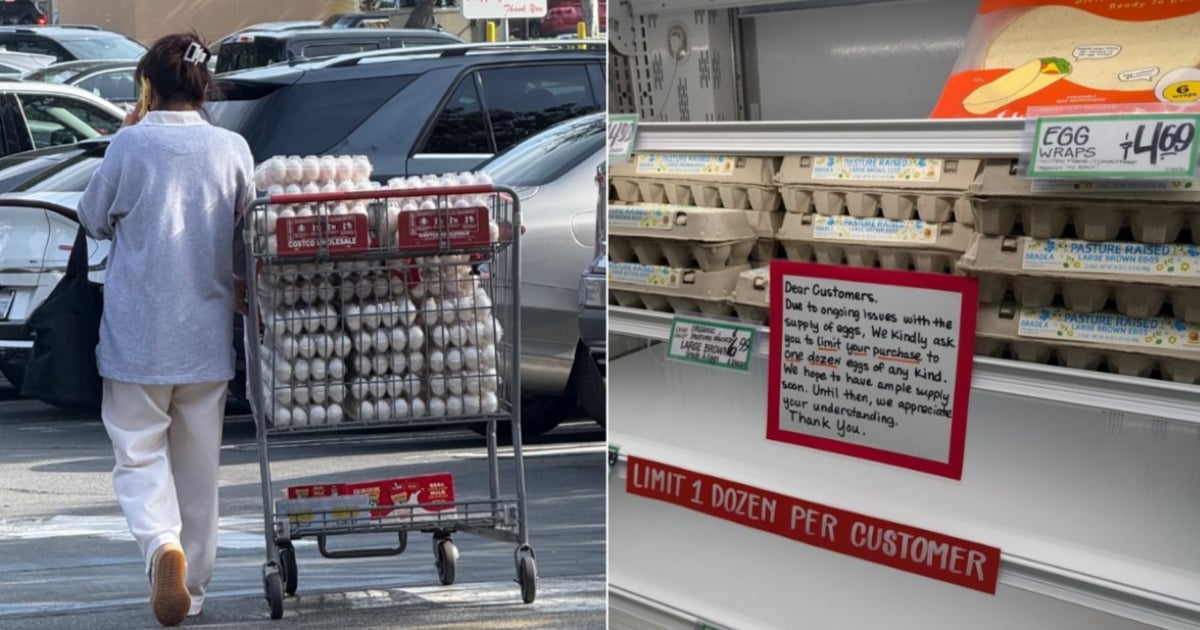
Related videos:
The price of eggs in the United States has reached alarming levels, with some stores selling a dozen for up to $10.50, which has led Costco and Trader Joe’s to impose purchase limits on the product in response to the growing scarcity and consumer panic.
According to reports on social media, long lines and scenes of frantic shopping have been observed at several Costco locations, with customers trying to stock up before the shelves are empty. In some cases, desperation has led to altercations among shoppers.
Trader Joe’s has implemented a stricter restriction, allowing each customer to purchase only a dozen eggs per day.
Costco is a membership warehouse chain originating from the United States that operates internationally. It is known for selling wholesale products at competitive prices, offering a wide variety of items that include food, electronics, clothing, household goods, furniture, and more.
The company has a presence in several countries, including the United States, Canada, Mexico, Spain, Japan, the United Kingdom, and others. It represents one of the largest and most successful retail chains in the world.
Trader Joe's, on the other hand, is another American supermarket chain known for its focus on exclusive products at affordable prices. It has over 500 stores in the United States, but does not operate in other countries. Its business model is based on offering high-quality products at competitive prices, without the need for a membership.
What is causing this crisis?
Experts indicate that the shortage of eggs is due to a combination of factors:
More Aggressive Avian Flu: A new variant of the virus has impacted poultry farms in several states, drastically reducing egg production and increasing the cost of inventory replenishment.
Regulations on Poultry Breeding: Some states have imposed stricter restrictions on animal welfare, limiting producers' ability to respond quickly to the crisis.
Inflation and production costs: The rise in prices for poultry feed, transportation, and energy has made production more expensive, resulting in record prices for the final consumer.
Increased demand for eggs: With the start of the year, the demand for eggs has risen in both households and the food industry, exacerbating the supply issue.
How long will the shortage last?
Despite the efforts of the authorities and producers to control the situation, it is estimated that the normalization of the market could take up to nine months. However, prices will continue to rise throughout the year, according to economists in the agri-food sector.
Meanwhile, consumers will need to adapt to the new reality by seeking alternatives or reducing their egg consumption. On social media, some users have started sharing recipes to substitute eggs in cooking, while others criticize the lack of measures to prevent shortages.
The egg crisis reflects the economic and logistical challenges facing the food market in the United States, where a combination of diseases, regulations, and macroeconomic factors continues to have a significant impact on the daily lives of millions of people.
Frequently Asked Questions about the Egg Shortage and Price Increase in the United States
Why do Costco and Trader Joe's limit the sale of eggs?
Costco and Trader Joe’s have imposed limits on egg purchases due to a shortage of the product, caused by factors such as avian influenza, regulations on poultry farming, and rising production costs. This has resulted in higher prices and increased demand for the product, leading to panic buying among consumers.
What are the causes of the egg shortage in the U.S.?
The shortage of eggs in the United States is due to several factors: a more aggressive outbreak of avian influenza that has impacted production, stricter regulations on animal welfare, rising production costs, and increased demand for the product. These elements have contributed to the supply shortage and rising prices.
How does the egg crisis affect consumers and restaurants?
The egg crisis has increased costs for consumers and restaurants, forcing the latter to raise prices or seek alternatives such as the use of liquid eggs. Consumers are facing higher prices in supermarkets and restrictions on purchases, prompting some to search for creative solutions or more economical alternatives.
How long is the egg shortage in the U.S. expected to last?
It is estimated that the normalization of the egg market could take up to nine months. However, prices will continue to rise throughout the year, impacting both consumers and the food industry.
Filed under: